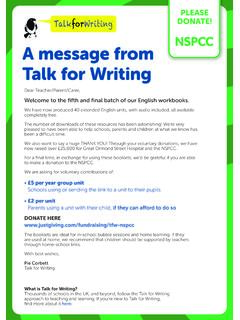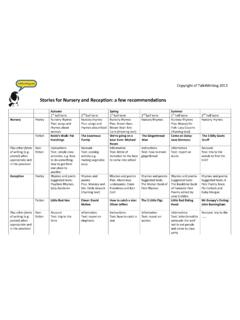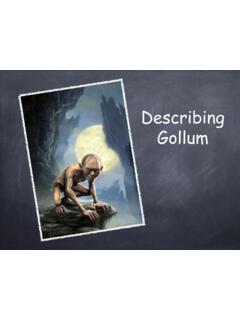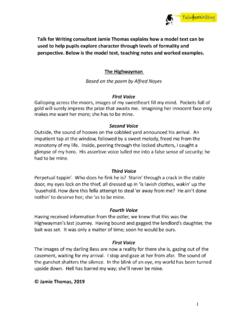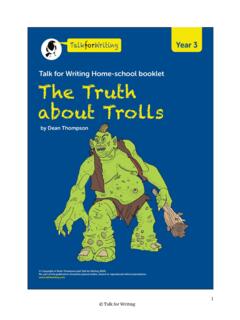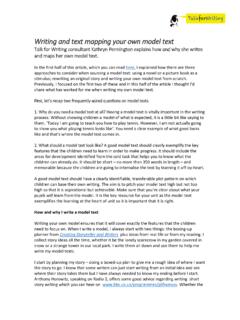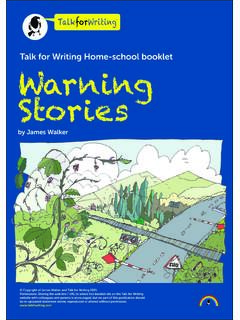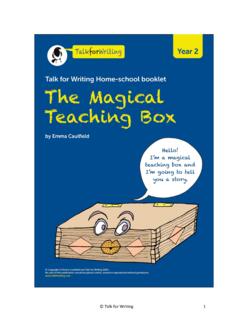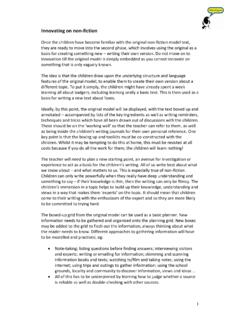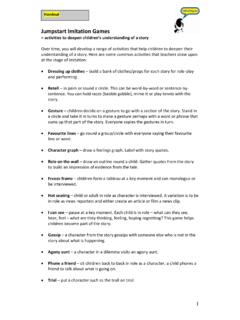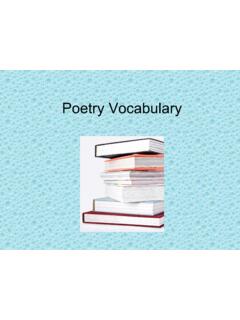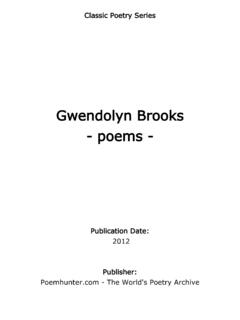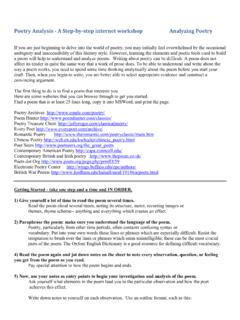Transcription of Building a Poetry Spine key stage 1 - Pie Corbett
1 1. Building a Poetry Spine key stage 1. The poems and rhymes that we share with children should be varied and powerful. Of course, the occasional joke poem is part of the repertoire but there is so much more. Schools should establish the idea of children learning a poem/rhyme a week, across key stage 1 and the early years. The rhyme or poem is learned orally in class each day, chanted or spoken together. There may be classroom activities built around the poem drama, model making, discussion, art work and so on. Furthermore, each child has a Poetry journal' and the rhyme or poem of the week is pasted into the journal. The journal is for the child to take home. It is not so much for the child to read, rather it is for the parents or carers to do' with their child.
2 The idea being that they read it together, say it at home, and on the way to school . In this way, a strong link is made with home playing an invaluable role in developing a love of words and gradually Building the bank of language. In some schools, older children have recorded the bank of rhymes and children take home a journal and, each term, an audio CD with older children saying/ singing the rhymes and poems. A school adopting such a system provides an impressive bank of some 90 rhymes and poems across early years and key stage 1. Imagine that such a rich storehouse of memorable metaphors, language, images, rhythms and movement. It seems unthinkable that children might slip through our hands without having experienced the joy of Inky pinky ponky ' or taking part in The Farmer's in his Den'.
3 Building up a bank of well-loved rhymes, songs and poems is an important part of early literacy development as well as a source of great joy. It influences a positive start in reading and writing and also adds to the basic storehouse of stories and images that lie at the heart of our world culture. Rhymes and poems can be learned orally using actions and a Poetry map and once known well, the children can then read them from the class Big Book of Poems and Rhymes. Poetry focuses upon words and sound. Babies play with sounds, savouring their tune and gradually learning their power as they start to name the world, bringing it steadily into being: learning that sounds can control what happens. However, recent research and the experience of many reception teachers suggest that the majority of children entering schools are only familiar with a handful of traditional rhymes.
4 It is worth asking children to tell you the rhymes they know on entry to school . Such attempts suggest that on average children only know a few Baa Baa Black Sheep' and Twinkle Twinkle Little Star' being the most popular. It is the traditional rhymes that begin to form the bank of language and patterns that are central to their early linguistic development. Given this strong link between early rhyme and reading and spelling (due to analogy see Usha Goswami's research), it is good news for all that the draft national curriculum has included this as an important and pleasurable strand. One teacher somewhat balked at the idea of revisiting poems and Building a cumulative and repetitive bank surely the children would become bored?
5 Of course the opposite is true. Children love to revisit old favourites in the same way that I still find myself playing the Beatles'. songs 40 years after I first heard them. There is a common human need to listen to and join in with basic patterns. For what is common to every culture across the world? It is the songs and poems, the stories, dances, music, religion and art that lie at the heart of all cultures. If these aspects of the curriculum are not at the heart of our schools, then we run the risk of having schools with no heart, no soul and the human spirit undernourished. If our children's education does not allow children to create and bring into being poems and stories then our education is just dry dust upon the wind.
6 2. Activity Establish rhyme/poem' of the week through the early years and KS1. Provide Poetry journals' for each child to take home so that parents can learn and enjoy rhymes with the children. Add in audio CDs. Ensure poems and rhymes are discussed and understanding deepened. Build up a prop' box for the poems, including your Poetry map plus any toys, objects or pictures needed to support initial understanding. Include an ideas card' that details possible activities that will help the children explore the world of the poem and deepen their understanding, increasing their pleasure. A dozen ways to establish a Poetry climate in school 1. Display rhymes and poems around the classroom and school in staff rooms, on the back of doors, on notice boards.
7 2. As a school , decide to read a poem a day' perhaps from one of the Macmillan Read Me' books. Have poet of the week' or each term every class focuses on a different poet, AA Milne. 3. Include a poem in all assemblies. Have a poem performed by each class in the school . 4. Create a poet tree' that has different branches (for different types of poem and for poets, the haiku branch, the Charles Causley branch). On the leaves the children copy up favourite words, lines, verses or poems. 5. Poetry box have a box of poems in the story corner that can be dipped into read out your favourites and explain what it is you like about the poem. 6. Poem swap if your class find a poem they love, then they can send it to another class . or swap with one of their favourites or perform it for another class.
8 7. Put poems onto cards children take a poem card home. Favourites can be learned by heart and performed. 8. Each class makes their own Bib Book of poems and rhymes that have been enjoyed and then swap. 9. Ask visitors to the class to choose and bring a poem or rhyme to share. 10. Tape a Poetry programme or get pupils to make a power point of poems transposed onto images or photos. 11. Start all staff meetings with a poem. 12. Each teacher sends a poem as a message to another teacher on every Friday morning for a term! Digging deeper Poems are not like sums they do not always easily add up. When reading Poetry , it is important to read it aloud because the impact hinges around the conjunction between the meaning and the music.
9 Here are some activities to help children dig under the skin of a poem: Read, discuss, explain, make statements and raise questions. Select the 5 most important words defend your choice. If you had 1 and words cost 10p which words would you buy? 3. Share or jot down your initial ideas, memories, questions, thoughts, similar experiences, feelings and share these in pairs. What was the most powerful picture? Highlight the poem make statements or raise questions. Use a colour to underline powerful words or surprising images. Use two colours one for sound effects (alliteration, onomatopoeia, rhymes, hard/soft sounds) and another colour for pictures (similes, metaphors). Prepare a class or group reading of a poem. Think about how to use voices, varying the pace, expression and volume to suit the meaning.
10 Make sure the words are clear add in percussive backing or sound effects, such as clapping, where relevant. Explain the poem to a friend. Give out a poem with no title discuss what it might be called? Cut a poem up by verses, lines or words to be re-sequenced. Omit key words and present a poem as a cloze procedure. Write a poem out as prose the children have to decide what pattern would look best upon the page. Respond to the poem in another form, painting, drama, a letter, diary entry, message, newspaper article. Illustrate a poem and annotate with words and images. Use a simple pattern for discussion, What we think the poem is about. What we think about it good bits, not so good bits and things I'm not sure about. Noticing techniques used alliteration, similes.
